Qinlang focuses on providing high-quality products and considerate services, and is committed to meeting every expectation of our customers.
The DKT-133 Cooling Ventilation Double Inlet Air Conditioning Fan is d...
See Details
Variable speed duct fans have become a popular choice for homeowners and businesses looking to improve air circulation efficiently. Unlike traditional fans that operate at a single speed, these fans allow users to adjust airflow according to specific needs, offering better control over indoor air quality and energy use. This article explores how a variable speed duct fan works, its main components, and why it can be a practical addition to HVAC systems.
A variable speed duct fan is essentially a fan installed within an air duct system, designed to move air through ventilation channels. The term "variable speed" refers to its ability to operate at multiple speeds, typically controlled by a dial, remote, or automated system connected to a thermostat. By adjusting the speed, the fan can provide a gentle airflow or a stronger circulation depending on the room size or temperature requirements.
To understand how a variable speed duct fan works, it is helpful to look at its main components:
| Component | Function |
| Fan Motor |
The motor powers the fan blades. In variable speed fans, it can run at different RPMs (revolutions per minute). |
| Fan Blades |
Blades move air through the duct. Their design influences efficiency and noise levels. |
| Speed Controller |
Regulates the voltage or frequency supplied to the motor, controlling airflow. |
| Housing and Mount |
Encases the fan and allows secure installation within ductwork. |
These parts work together to deliver adjustable airflow. The fan motor responds to the speed controller, which changes the motor's electrical input, allowing the blades to spin faster or slower.
Variable speed duct fans can be connected to thermostats, timers, or smart home systems. When integrated with temperature sensors, the fan can automatically adjust its speed to maintain a consistent environment. For example:
This flexibility allows homeowners to balance comfort and energy efficiency without manually adjusting the system constantly.
A key advantage of variable speed duct fans is their energy efficiency. Traditional single-speed fans consume the same amount of electricity regardless of demand. In contrast, variable speed fans can run at lower speeds when full power is unnecessary, reducing energy consumption and extending the fan's lifespan.
Maintaining a variable speed duct fan is relatively simple but essential for long-term performance. Common practices include:
Regular maintenance ensures smooth operation and helps avoid potential issues with airflow or motor performance.
A variable speed duct fan works by adjusting the motor speed to control airflow within a duct system, providing flexible ventilation and energy efficiency. Its combination of a controllable motor, blades, and speed controller makes it a practical solution for modern HVAC systems. By understanding how it operates and maintaining it properly, users can enjoy consistent indoor air circulation with lower energy costs.
Incorporating a variable speed duct fan can make a noticeable difference in comfort levels and efficiency, making it a useful addition to both residential and commercial settings.